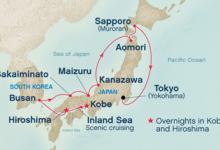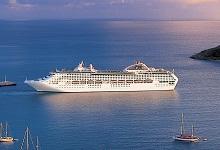Recently Viewed Cruises
- Sun, Round Japan from Kobe ex Kobe to YokohamaAdd to favourites
- Sun, Kyushu & Korea ex Yokohama ReturnAdd to favourites
- Sun, Golden Week ex Yokohama ReturnAdd to favourites
- Shadow, Voyage 3311 ex Hong Kong to TokyoAdd to favourites
- Pacific Princess, World Cruise 2013 Sector ex Sydney to Hong KongAdd to favourites
- Oceanic Discoverer
- Ab Fab Oosterdam
- Catch up on Cruising: Latest cruise news in bite size
- Catch up on Cruising: Latest cruise news in bite size
- Catch up on Cruising: Latest cruise news in bite size
- Frequently Asked Questions
-
Sun, Round Japan from Kobe ex Kobe to Yokohama
Nights 12 Ship Sun Princess Star Rating 
Departs Kobe, Japan Sailing 2013: 2 Jul Ports of Call Kobe, Hiroshima, Busan, Sakaiminato, Maizuru, Kanazawa, Aomori, Sapporo (Muroran), Yokohama Please enquire about this cruise for pricing.
12 Night Cruise sailing from Kobe to Yokohama aboard Sun Princess.
Sun Princess - along with its sister ships Dawn and Sea - has more than 400 balcony staterooms, so you can wake up to your own exclusive vista. Take a dip in one of three spacious pools or spend your evening at one of the show lounges with unique performances each night. Dining options are also plentiful, including two formal dining rooms, the Sterling Steakhouse and the 24-hour Horizon Court. And don't miss the Lotus Spa for some pampering.
Highlights of this cruise:
Hiroshima
On August 6, 1945, human history was irrevocably altered when the American bomber Enola Gay dropped an atomic bomb on Hiroshima. The bomb was code-named "Little Boy," but its detonation left half the city in ruins and aflame. Today, Hiroshima is a monument not only to the destructive forces harnessed by men but also to the indomitable will of the human spirit to overcome tragedy. At the heart of the city lies Peace Memorial Park and the Atomic Bomb Dome. The gutted walls of the city's old Industry Promotion Hall and the skeletal frame that supported its copper dome, vaporized in the blast, are instantly recognizable symbols of Hiroshima.
Travelers to Hiroshima will discover a more serene note at nearby Miyajima Island. One of the top-three scenic spots of Japan, the island is home to ancient Itsukushima Shrine, a designated National Treasure.
Busan
The second largest city in South Korea, Busan is your gateway to a fascinating land whose culture is a unique amalgam of old and new. Modern high-rise towers dwarf ancient Buddhist temples. The city's bustling business district offers a stark contrast to the serene grounds of Yongdusan Park. In short, Busan is a microcosm of South Korea, a nation whose startling economic success often obscures one of Asia's most sophisticated and venerable cultures.
Busan was the scene of bitter fighting during the Korean War. The United Nations Memorial Cemetery marks the final resting place for the troops from 16 nations who gave their lives during the conflict.
Maizuru
By virtue of its name being Maizuru (Japanese for a crane spreading its wings), this city welcomes you in with open arms, inviting beaches and phenomenal views. Established as a naval port in 1901, Maizuru became increasingly important during the Russo-Japanese War that followed and still serves as a center for the Japan Maritime Self-Defense Force today. Dive into maritime history at the Maizuru Naval Museum, where you’ll discover artifacts from Maizuru’s seafaring past leading up through World War II. Or check out Shiroyama Park where the magnificent Tanabe Castle once stood. From the historical to the unusual, Maizuru is also home to the World Brick Museum, where you’ll gain insight into bricks from across the globe and can see all of the locations in Maizuru built with red bricks, which were introduced to the area in the early 20th century.
Aormori
The capital of the Aomori Prefecture in northern Japan, Aomori derives much of its beauty from the apple orchards and cherry blossoms that encompass its landscape and the snow-covered Hakkoda Mountains that look on from a distance. Throughout its history, the city has been stricken with misfortune time and time again - in 1910, a fire destroyed Aomori, and during World War II, the city was left in ruins following an air raid - yet it always prevails.
Aomori is cherished by many who believe a local legend that the grave of Jesus Christ lies within the southern part of Aomori prefecture. However, Aomori is perhaps best known for its renowned Nebuta Festival, an elaborate yearly event in which participants illuminate giant paper representations of samurai warriors, animals, and popular cartoon characters while parading them through the streets.
Yokohama
Yokohama and Edo began life as sleepy fishing villages. That changed in the early 17th century after Tokugawa Ieyasu became Shogun. Edo became the center of political power in Japan, a position the city retained even after the restoration of Imperial rule in 1866.
Contemporary Tokyo may be the most astonishing city on earth. It's a paradoxical mix of ancient tradition and postmodern culture. The Ginza - an international shopping mecca - stands near the serene grounds of the Imperial Palace, and the hyper-speed of 21st century consumerism is mysteriously reconciled with the elegance and serenity of traditional culture. Tokyo provides the traveler with a dizzying experience.
With the Meiji Restoration of 1868, Edo was renamed Tokyo, the "Eastern Capital," to distinguish it from the old imperial capital at Kyoto, the "Western Capital."







